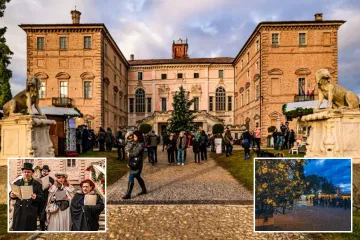I went to the Portuguese city known for its very phallic pastries

JUST an hour away from Porto in Portugal lies a historic riverside city with a curious culinary tradition.
Amarante, perched on a bend of the Tamega river, has become widely known for its pastries — not because of their flavour or filling, but their shape.
The treats, named bolos de Sao Goncalo after the local patron saint, are baked to look like a particular part of the male anatomy.
Many believe they are a nod to Saint Goncalo’s success as a matchmaker, after he supposedly helped scores of single women and widows find husbands.
But the pastries’ story actually dates to medieval times.
As I tour the Sao Goncalo Church and Monastery, I learn that the shape is reminiscent of the ancient rituals and traditions related to prosperity and the fertility gods.
Over time, the cakes gradually became associated with Saint Goncalo, and even though they were banned during Portugal’s dictatorship, which ended in 1974, they have since been embraced by the people of Amarante as a proud symbol of local identity.
People who are looking for love or hoping to start a family still visit the monastery today, reciting a hopeful prayer while clutching the rope belt on his statue.
Decorated inside with ornate gold leaf carvings and traditional Portuguese tiles, the beautiful 400-year-old building is worth a visit, regardless of your hopes for love.
But I was more interested in sampling the phallic pastries.
Confeitaria da Ponte, the city’s oldest bakery — so named because of its proximity to the bridge — is a great place to try the much- loved bakes.
Owner Joana Machado tells me that Amarante delicacies are generally made with lots of egg yolks.
This includes their house speciality — a moist, round, bite-sized confection coated with sugar that is also called a bolo de Sao Goncalo, although this one looks far less phallic.
“The recipes began in the monastery,” she explains. “Nuns used the egg whites to iron the clothes, so they used the yolks for baking.” The famous pastel de nata, or Portuguese custard tart, is another example of a “conventual” sweet (meaning originating in a convent).
At riverside cafe Casa dos bolos de Sao Goncalo, on Rua 31 de Janeiro, the classic penis cake has been given a modern update.
The choux pastry case is filled with pistachio cream and topped with a drizzle of green chocolate in an apparent nod to the Dubai chocolate trend that has recently taken the world by storm.
I can’t help but giggle as I slice a piece off the top of the golden brown treat.
Tasty souvenirs
The pastry is crunchy on the outside and chewy in the middle, while the pistachio filling adds a sweet, nutty flavour.
I can certainly see why these cheeky cakes have been popular for centuries!
You’ll want to dine on more than just sugary treats, though — and there are plenty of places to do that.
Northern Portuguese cuisine is more meaty than in the south, where seafood reigns supreme, and the regional speciality, slow-roasted veal, does not disappoint.
Lusitana is an excellent spot that was recommended to me by the staff at my hotel, Casa do Ribeirinho. Here, thick slices of tender, juicy meat are served with roasted potatoes and rice. The hearty meal is affordable, too.
Mains for two, a shared goat’s cheese starter and chocolate mousse for dessert with two glasses of wine costs €24 each (around £21).
For a slightly more upmarket dinner, try Ze da Calcada, which also serves regional dishes such as chicken with chestnuts, mushrooms, sweet potatoes and green beans, as well as local wines from the Douro valley.
Mains are typically €16 each (around £14).
Before you depart Amarante, be sure to visit the stall outside the Municipal Museum Amadeo de Souza Cardoso.
Dedicated to the modernist painter after whom it is named, it is currently closed for renovations.
But the stall is a great place to stock up on tasty souvenirs.
It is laden with phallic cakes of all different sizes, some of which are crunchy like biscuits and individually wrapped with colourful ribbons.
More robust than the choux pastry variety, they make the perfect take-away treat for yourself — or a great tongue-in-cheek gift for someone who needs a bit of luck in the love department.
GO: AMARANTE
GETTING THERE: The nearest airport is Porto. Ryanair flies from Stansted to Porto from £35 return. See ryanair.com.
STAYING THERE: Rooms at Casa do Ribeirinho cost from around £68 per night. See casadoribeirinho.pt.



